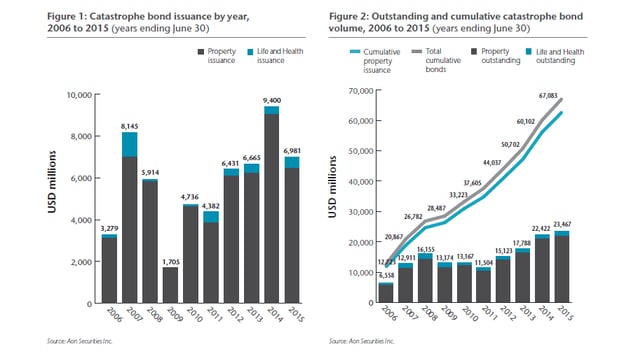
With ILS (insurance-linked securities) heading into the London Market, every effort is being made to push the corporation tax legislation through in 2016. UK companies will then be able to make the most of the business opportunities on offer.
So, what is this ILS regulation and what makes it different from traditional (re)insurance?
HMR&C states that ‘ILS are a means of transferring insurance risk to capital market investors’. This means that ILS/CAT Bonds are usually issued by means of a so-called Special Purpose Vehicle (SPV) which are specially designed subsidiaries in order to provide (re)insurance protection to insurers, reinsurers, governments, and corporations.
CAT bonds allow companies to obtain (re)insurance protection from a pool of capital that is separate from traditional reinsurers. Money managers, hedge funds and pension funds are providing a new pool of capital against payment of “interest” instead of premiums on the capital invested.
The first ILS was issued in 1997 (as a consequence of Hurricane Andrew causing USD 15.5bn of insured losses in 1992) and they were initially only used to transfer NAT CAT risks such as hurricane and earthquake to capital markets in order to help with diversification of risk for both the ILS issuer and the capital markets. Today there are also other types of ILS, both life and non-life, but CAT bonds still are the most common type of ILS.
One of the fundamental differences between insurance and ILS, is that in order to give more comfort to capital markets, there is no insurance wording. Instead there are very well defined trigger(s) for payment and the principle of indemnity does not apply, i.e. when the agreed trigger(s) are fulfilled, payment is due, even though there may not have been an actual loss suffered by the bond issuer.
ILS activity has been continuously growing over the years. This can be seen in the statistics below from Aon Benfield who are the largest global ILS security broker.

In order to enable the UK to profit from this market and to remain an innovative and attractive financial services domicile, the UK government intends to introduce a new regime which will cover the structure, supervision and taxation of special purpose vehicles, and the possible development of secondary trading facilities.
With interest rates as low as they currently are, and whilst they are looking to remain that way across the globe, non-insurance financial institutions see ILS as a relatively safe haven for their funds. A haven which looks likely to provide a significantly improved return on investment when being compared to more traditional mid to long term investment methods. Investors would be set to receive a share of the premiums as a return on their investment. Of course, as any investment does, this still holds a risk. The ILS issuing company (SPV) would usually charge a service fee and it must be understood by the investor that claims made, may well exhaust the entire capital invested.
This opportunity is soon to be readily available. Those planning on getting in on the action must be able to manage and report on the different funds that are held on behalf of any shareholder. In order for premiums and claims to be allocated correctly to the different participants, detailed data on about each stakeholder must be maintained and utilised. There is, therefore, great emphasis on having a system that allows you (as a (re)insurer) to hold and report on this whole new category of data that is associated with the investments and the policies you write. Provided the systems in place are robust enough to handle the data capture and reporting requirements, the introduction of ILS should in no way require an increase to your head count, nor should it increase the complexity or the number of processes involved with the investment.
Whilst Bermuda has embraced this method for a number of years and is considered somewhat of a centre of expertise, there is currently only about 10% of the ILS capacity traded in London. So, fast-tracking your route into the ILS market could be easier than you think, especially if you can tempt the expertise away from Bermuda and other offshore markets back to the UK. To help move things along and to encourage the movement into the UK, the wider London Insurance Market needs to deliver a systematic solution to allow carriers to enter the market without fear of increased functional costs.
